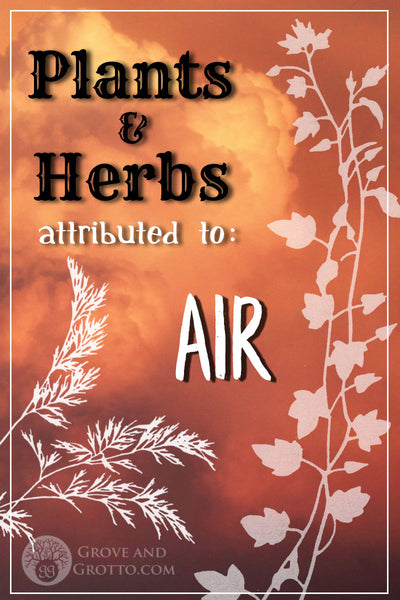
What types of plants are attributed to Air? Once you read this article, you won't need an almanac to find the Airy herbs in your garden or spice cabinet.
Elemental correspondences are a factor in a lot of herbal magick. The assignment of plants and herbs to Earth, Air, Water, Fire (or a combination of these elements) can be traced back to medieval medicine. In pre-modern times, diseases were thought to be due to an imbalance in the four humours, ruled by the four elements. By ingesting or applying plants related to the proper element, herbal healers could attempt to bring the body into balance.
The practice of medicine has (fortunately) advanced. But elemental correspondences are still used by those who work with the energy of plants. Earthy, Airy, Fiery or Watery classes of plants all have distinct properties and uses in magick.
It's easy to look up herbal correspondences, of course--but it's far more useful to understand why certain plants fall under the influence of one element or another. In this article (first of a four-part series), we'll look closely at plants that are usually attributed to Air. (Keep in mind that some plants have two or more elemental correspondences: Oak, for instance, is said to be both Earthy and Airy.)
Below are some attributes of Air plants. Not all Air plants will have all of these traits, but the more that apply, the more likely the herb belongs to Air.
Corresponds to Mercury, Jupiter, or Uranus.
Plants ruled by one of these three Airy planets will usually be Airy themselves. (Makes sense.)
Lives in the air, or travels by air. (Poplar, Cottonwood, Moss)
Tall, sky-spanning trees have a natural affinity for Air. So do rootless plants. Mosses and bromeliads grow on branches and take their nourishment from the breeze. That's about as Airy as it gets! Maple, with its helicoptering pods, is another Airy tree. The leaves and flying seeds of any plant are the Airiest part, followed by branches.
Lightweight. (Aspen, Marjoram, Cilantro)
Plants with lightweight wood, branches, or leaves are likely to be attributed to Air. A bundle or sheaf of an Airy plant will tend to be lighter than it looks.
Fresh, clean fragrance. (Lavender, Rosemary, Lemongrass, Anise, Oregano, Peppermint)
Perfumes of Air are bracing, refreshing, herbal and aromatic. (In contrast to the heady florals of Water or woods and musks of Earth). This makes Air herbs a popular ingredient in the magick of cleansing.
Masculinity. (Fennel, Asparagus, Celery, Cattail)
Air is a masculine element. If any part of the plant looks phallic, or thrusts up from the ground in shoots or stalks, pay attention. The ancients certainly noticed and assigned that plant to Air!
Wisdom-bringing plants. (Hazel, Almond, Bay, Borage, Frankincense)
Knowledge and wisdom fall under the sway of the element of Air. Plants that are used to bestow eloquence, prophetic ability, or astral flight are Airy in nature. So are many "lucky" plants (like Clover) and traditional incenses.
Prolific or fast-growing. (Poppy, Caraway, Ivy, Cashew)
Air is the element of swiftness and expansion. Many nut-bearing trees are assigned to Air. Like lusty Jupiter (who is ruled by Air), Air plants tend to spread their seed.
Yellow color. (Dandelion, Yarrow)
In Western Magick and Wicca, yellow is the color attributed to Air. If an herb has yellow leaves and flowers, that may be enough to tip it into the Air category.
Parasitic or opportunistic plants. (Mistletoe, Oakmoss, some mushrooms)
Here's one of the less-positive aspects of Air: It doesn't have much identity of its own. Some Airy plants are able to adapt to their environment and get what they need without sprouting roots. Hydroponic plants have trained us to take care of them, and can easily be moved from place to place--they may be the most advanced Air plants of all.
Hope you found this article helpful! Read more from articles here.
